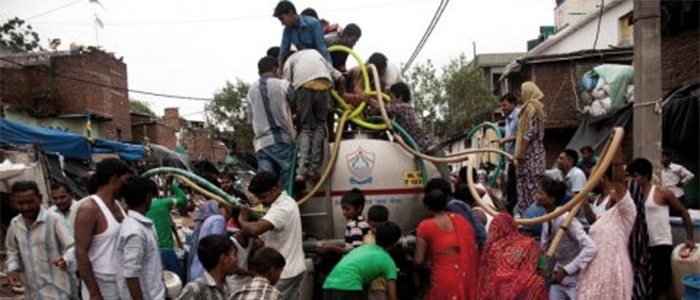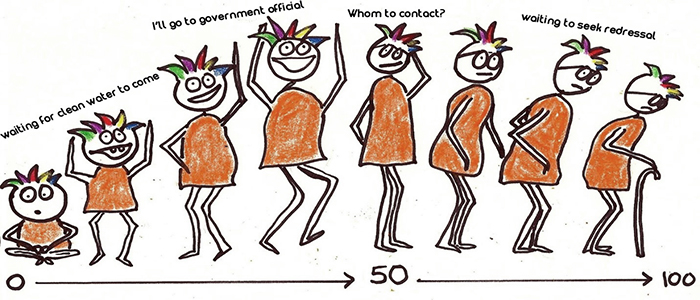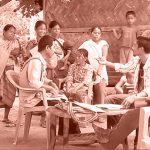
Water Problems in a South Delhi Slum – Challenges of Access, Usage and Awareness
18 May 2017
This is the second part of an eight-part series on the challenges and life hacks in experiencing and accessing government benefits and services.
The problem of acute shortage of clean drinking water is old for the streets of Gola Kuan, Okhla Industrial Area. Supriya (name changed) who works as an Asha (Anganwadi) worker in the community of Gola Kuan has been a witness to this problem since the past five years. The Tanker which is supposed to supply water in that community (a facility which started since Aam Aadmi Party came to power) caters to the basic needs of only twenty families out of a hundred, she explained. “The quality of water is poor and cannot be used for drinking purpose as there are foreign particles in it and it tastes bitter. Also, the water received through the pipeline is contaminated.”
Housewives have to walk some long distances to get water from the bore well. This also increases the economic burden on their families as they have to spend approximately Rs. 1000-1200 per month to buy clean drinking water from private shops. Families thus have to resort to adding chlorine tablets in the water as an alternate measure to keep their water clean (procured and distributed by Asha Workers under ‘family planning’).

The difference between “access to water” and “access to clean drinking water” is often not very well acknowledged by the Babus. Further, the issue is compounded by the fact that there is a lack of awareness on the right departments and authorities to approach in order to register complaints.
“..Vidhayak ke paas jaate hein. AAP sarkaar ke vidhayak ke paas mei 2 baar gayi thi. Likhit roop se kuch nahi diya tha bas bola tha unhe ki dikkat bohot hai. Unhone kaha ‘hum dekhenge’.”
(We went to the MLAs office. I went to AAP Party’s MLA who is in power to register the complaint. I did not submit any letter or form. I verbally communicated the problem and he said that he will look into the problem.)
Yes, approaching the Delhi Jal Board (DJB) would have crossed most of our minds. However, there were some crucial factors that the people of Goal Kuan had to weigh before settling for a course of redressal in this case. Instead, they approached the MLA in the area as a way to navigate the risks and bureaucratic hassles that came with the DJB (such as spending the whole day at the adhikaari’s office without the assurance of getting redressal and losing a day’s wage).
“..Vidhayak yahi ilaake mei rehte hein. Unke paas jana zyada araamdayak lagta hai. Vaise bhi madam itne saal hogaye koi dhang se toh kuch karta hai nahi. Agla MLA aayega toh election ke time pe suvidhayein mil jayengi uske baad ka koi nahi dekhta. Tanker ki suvidha bhi election ke baad AAP Party ke aane par hue thi. Usse pehele kabhi kuch nahi hua.”
(The MLA lives in this area. It is more convenient to approach him. Madam, it’s been so long since anyone addressed this problem – no one takes proper action to address it. We’ll get some services around elections but no one looks after the service once the election phase passes. The tanker facility also started after elections when AAP Party came to power.)
Where is the solution?
The Delhi Jal Board promises to supply sufficient quantity of water to its people. Approximately 1000 liters of water is to be provided to each family at a gap of 2 days or a week depending on the requirement, explained the DJB ‘helpline’ spokesperson when I phoned in. Talking about this particular area, pipelines are spread across the whole zone and tankers have been sent ‘hamesha se’ to cater to the needs of its people, explained an adhikari of DJB.
Well, it might sound easy at first to just pick up your phone, dial the toll free number and reach out to the authorities, as it has been advertised. But is it as convenient as it sounds? When I finally got through to the Delhi Jal Board’s ‘helpline’ the spokesperson suggested that I contact the Executive Engineer of that area. Navigating the matrix of zones and departments (like Water, Water sewer, Water maintenance etc.) listed on the DJB website and deciphering the confusing acronyms to finally get the appropriate phone number was a challenge to a comparatively technically sound person like me. The Executive Engineer further directed me to contact the Junior Engineer, without fully acknowledging the concern and information that I needed. On learning that I was no victim of this problem the Junior Engineer nullified the questions raised by saying:
“..Madam kya baat kar rahe ho aap. Yahan koi dikkat nahi hai. Paani properly supply hota hai. Aap office mei jaake baat karo.”
(Madam, what are you saying? There is absolutely no water problem (with respect to quality or quantity) in this area. Sufficient water is supplied. You please go to the office and have a conversation with the concerned person.)

Can a family of five living in a small room with an open drain right at the entrance of the room struggling to meet the need of ‘do waqt ki roti’ be expected to go through this whole maze for a ‘quick and easy redressal’? The lack of awareness on the ‘redressal systems’ and the problem of approachability attached to it doesn’t make for a very clear cut and convenient option for many. This is especially so for those who have to anyway fight daily battles of managing ‘dihaadi’, ‘paisa’ and ‘beemari’.
Possible measures to address water woes in Delhi
- DJB Helpline Number: 1091 (Toll-free)
- DJB Website: Homepage – http://bit.ly/1BqF6uh Contact address – http://bit.ly/2rWWixc
- Other links: Citizen’s Charter charting out all possible procedural steps to be undertaken in case of water related troubles – http://bit.ly/2shyL7F
- DJB representatives actively acknowledge problems and respond to complaints on their social media page (Facebook) – https://www.facebook.com/delhijalboardofficial/
- In case the Citizen is aware of the ‘Zone Number’ of his/her area, then he/she can directly contact the ‘Junior Engineer’ associated with that area (number available on http://bit.ly/1CrOvAN)
- Other contact persons: MLA or local representative of that area can be personally contacted regarding such issues.





